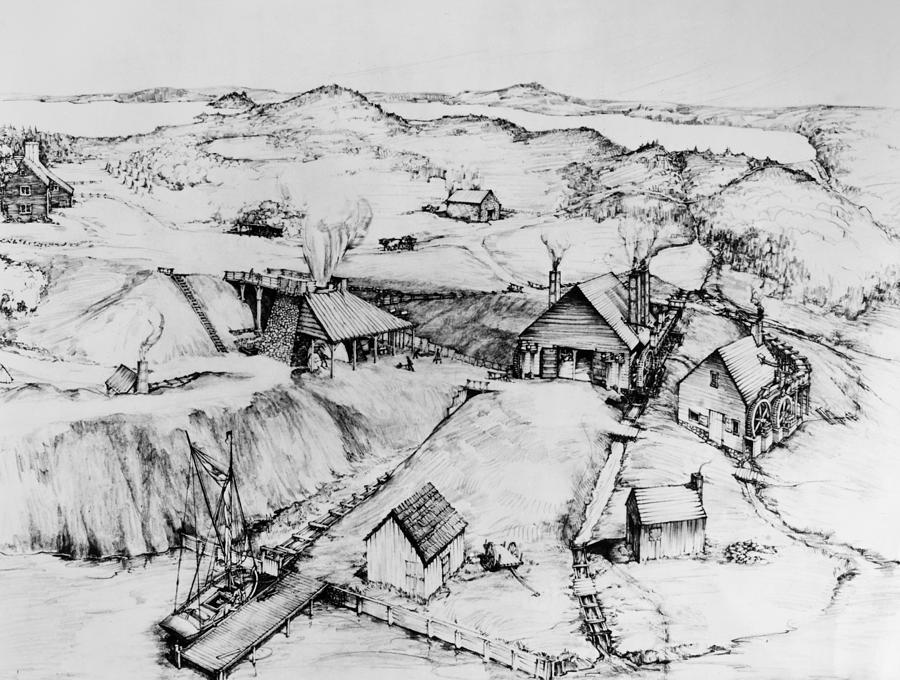The Iron Works is not the only thing that Saugus was the home of...in fact, Saugus was home to many firsts. Now, before I go further, if you fact check me, then you might see some of these examples are disputed, but I stand by my research.
At the time of the Iron Works, many people who traveled to Saugus had specific jobs that they did. One of those men was Joseph Jenckes. Jenckes was a blacksmith at the Iron Works. Mostly, it was his job to fix broken things. He also made new things while in Saugus. After someone invents something, they need to get a patent to protect their invention. It prohibits people from stealing their idea. Jenckes was the first person in North America to file a patent for a machine he built. In fact, Jenckes filed quite a few patents:
- Machine Patent: Jenckes first patent was for a machine to help him make iron tools.
- The Jenckes Scythe: A scythe is a farming tool used to quickly cut grain or wheat. It can also be used as a weapon. Jenckes created what we now call the American Scythe. It is relatively the same tool today as what he created.
- The Pine Tree Shilling: Jenckes is not credited with creating this coin. History knows the name of its creators, but Jenckes probably helped make the tools they needed to make the first English money made in America.
- The First Fire Engine in America: Not all fire engines are the same, Jenckes made this first engine for the city of Boston. The engine was basically a giant tub with a pump on it. Jenckes put it on wheels. When a fire alarm was called, the tub was taken to the fire and the pump was used to put water onto the flame.
- Joseph Jenckes, Jr: This one is a bit of a joke, but the younger Jenckes left Saugus and help settle Pawtucket, Rhode Island. He was also an ironworker and blacksmith. The Jenckes family lineage still works in the American steel industry (according to legend) and adds credibility to the Saugus Iron Works being the birthplace of American industry.

 |
| An artists depiction of Joseph Jenckes, Jr. settling at Pawtucket, RI |
Saugus history continued through the ages and many important events happened here, or near here, throughout the 16 and 17 hundreds. Our next big first, however, was developed in the early 1800s. Actually, within the first few years of the new century, Saugus saw two important firsts be established. In 1803, the Newbury Turnpike was built to connect Boston to the ports north of the city. Saugus held the first tollhouse on the new roadway. It would be over a hundred years before automobiles would travel down Route 1, but the highway has been bringing business in an out of our town ever since. One of those businesses, established as early as 1804 was created by the Tudor family of Boston. Tudor is known as the Ice Prince. He came up with a brilliant idea of cutting into New England ponds during the winter months and delivering the ice to warmer climates as far away as the Caribbean Sea. Tudor's first expedition was reported in the Boston Gazette, "No joke. A vessel has cleared at the Custom House for Martinique with a cargo of ice. We hope this will not prove a slippery speculation." [First, I love the "no joke." Second, congrats to the Boston Gazette for using a pun. Thirdly, they used speculation...that is a word we've used a lot in class] The Tudor farm in Saugus was located at the site of Saugus High School and the Square One Mall. Isn't that cool!
 |
| Photograph of the Tudor farm circa 1900. |
_circa_1913.png/800px-Harry_Nelson_Atwood_(1883-1967)_circa_1913.png) |
| Harry Atwood. He was married a total of five times! |
Saugus was also the first community to adopt the Massachusetts Plan E of local government. We are currently the only community that uses that same form, although it has been altered along the way. Modern Saugus is still making history, but these early firsts helped put our little town on the map and into the history books. From our first settlers to our most recent residents, Saugus people have contributed to the rich landscape of America's past. In a future episode, I will dig further into some of the people who made Saugus famous, but for now, I thank you for your time.
Before you go...do you have any questions for me? Want to see me answer questions about Saugus' past while I eat hot wings. In an effort to make this separation from school more fun for my students, I am going to make a Saugus edition of YouTube's "Hot Ones." Feel free to contribute by submitting a question here: Hot Wings Questionnaire
Activities:
- Choose one of Jenckes first inventions and research it further. How important was it for an early blacksmith to fix broken things and invent new things in colonial America?
- Invent something of your own. Draw it, write about what it would do, and deliver a sales pitch to someone at home. Do you have the next great thing...submit it to Shark Tank.
- Write a newspaper article from Martinique upon the arrival of Saugus ice. What would people think? Who bought the ice? Did Tudor make a lot of money selling the ice to the people on that island? Create an advertisement for his ice.
- Find another first from Saugus or Massachusetts. Tell a friend about it or someone at home.


No comments:
Post a Comment